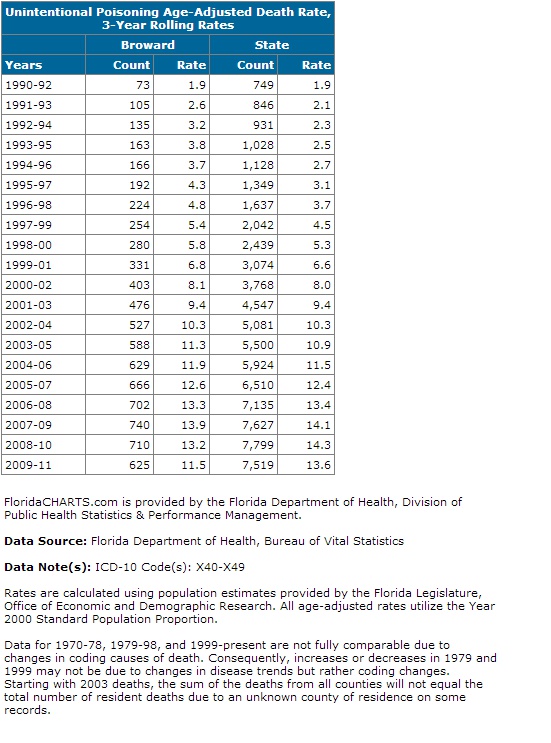Broward County Poisoning Statistics
Every year, people are poisoned and suffer serious injury, with many victims of poisoning dying as a result. Many of these poisoning victims are children, and while poisoning can be the result of food, lead paint, or environmental contaminants, the sad truth is that most poisoning victims today are injured by drug poisoning.
United States Poisoning Injuries
According to the Centers for Disease Control, poisoning injuries resulting in death are a very serious problem in the United States today:
Since 1992, the number of deaths caused by accidental poisoning has risen each year.
Each year in the United States, accidental poisoning kills more people between the ages of 25 – 64 years than anything other than car accidents.
Over 80% of children taken to Emergency Rooms in 2010 were seen because of accidental poisoning involved kids taking medications while unsupervised.
In 2010, Poison Control Centers were contacted for help in approximately 2,400,000 instances of accidental exposure to poison (eaten, inhaled, etc.).
The National Vital Statistics System has charted the instances of drug poisoning death rates in the United States for several years. From their research are the following findings (as shown in the following graph):
The U.S. poisoning death rate has almost tripled over the past 30 years.
The number of drug poisoning deaths has skyrocketed from about 60% to about 90%.
Almost all poisoning deaths in this country (approximately 90%) are caused by drugs.
In 2008, 76% of poisoning deaths were unintentional, 16% were suicides, and in 8% the intention could not be determined.
2013 Food Safety Update: In April 2013, the Centers for Disease Control announced the release of the Foodborne Diseases Active Surveillance Network (FoodNet) report which included the following findings:
- 2012 rates of infections from two germs spread commonly through food have increased significantly when compared to a baseline period of 2006-2008, while rates of most others have not changed during the same period.
- Infections from campylobacter — which is linked to many foods, including poultry, raw milk and produce – has risen up to 14 percent in 2012 compared to 2006-2008. They were at their highest level since 2000.
- Vibrio infections as a whole were up 43 percent when compared with the rates observed in 2006-2008. Vibrio vulnificus, the most severe strain, has not increased. Foodborne vibrio infections are most often associated with eating raw shellfish.
Florida Poisoning Injury Statistics
According to the Florida Department of Health, not only are injuries the number one cause of fatalities for people ranging in age from infants to their mid-forties (ages 1-44), according to the latest available data, Florida’s age-adjusted injury death rates were higher than the national average by 37.7% for unintentional poisonings.
According to the Centers for Disease Control and Prevention’s study of Florida poisoning deaths using data from the Florida Medical Examiners Commission:
From 1990 to 2001 in Florida, the non-suicidal poisoning death rate increased 325%.
From 2003 to 2009 in Florida, the number of annual deaths in which medical examiner testing showed lethal concentrations of one or more drugs increased 61.0%.
Death rates in Florida caused by prescription drug poisonings jumped 84.2% during the same time period.
Poisoning deaths in Florida from oxycodone skyrocketed by 264.6%.
Poisoning deaths in Florida from alprazolam rose 233.8%.
In 2009, the number of deaths involving prescription drugs was 400% more than the number involving illicit drugs.
Broward County Poisoning Injuries
In Broward County, Florida, unintentional poisonings are a serious injury concern. As shown in the following chart compiled by the Florida Department of Health’s Bureau of Vital Statistics, from 1990 to 2011, deaths from poisoning have risen almost a hundred-fold, from 73 to 710.

Sources:
